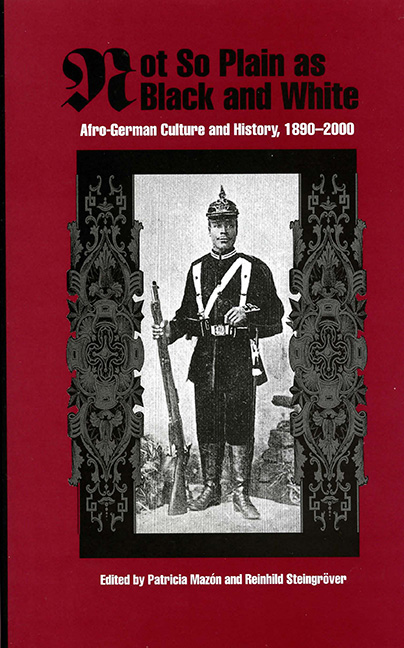Book contents
- Frontmatter
- Contents
- Foreword
- Introduction
- Part I Afro-Germans in Historical Perspective
- 1 Dangerous Liaisons: Race, Nation, and German Identity
- 2 The First Besatzungskinder: Afro-German Children, Colonial Childrearing Practices, and Racial Policy in German Southwest Africa, 1890–1914
- 3 Converging Specters of an Other Within: Race and Gender in Pre-1945 Afro-German History
- Part II Cultural Representations and Self-Representations of Afro-Germans
- Selected Bibliography
- Notes on Contributors
- Name Index
3 - Converging Specters of an Other Within: Race and Gender in Pre-1945 Afro-German History
from Part I - Afro-Germans in Historical Perspective
Published online by Cambridge University Press: 11 May 2017
- Frontmatter
- Contents
- Foreword
- Introduction
- Part I Afro-Germans in Historical Perspective
- 1 Dangerous Liaisons: Race, Nation, and German Identity
- 2 The First Besatzungskinder: Afro-German Children, Colonial Childrearing Practices, and Racial Policy in German Southwest Africa, 1890–1914
- 3 Converging Specters of an Other Within: Race and Gender in Pre-1945 Afro-German History
- Part II Cultural Representations and Self-Representations of Afro-Germans
- Selected Bibliography
- Notes on Contributors
- Name Index
Summary
In his early, seminal volume on the figure of the Black in German culture, On Blackness Without Blacks, Sander Gilman argued that the uniqueness of the German conception of Blackness lay in its paradoxical development in the virtual absence of a Black presence. Gilman maintained that in Germany, the image of Blackness developed independently of an “external reality,” composed rather of “elements taken from external traditions and altered to fit certain needs of a radically different culture.” He described this image as “an accretion of borrowings which were altered and shaped to create patterns into which these projections were cast.” According to Gilman, this “mirage of Blackness” defined German responses to Blacks when the latter were eventually confronted “in reality.” Yet as more recent analyses of German colonial history and the history of Blacks in Germany have demonstrated, German conceptions of Blackness and Black Germans in particular have been shaped in profound ways by a series of encounters with Blacks both domestically and in its former colonial territories. As part of this emerging body of literature, this essay attempts to add an important historical dimension to our understanding of contemporary articulations of Black German identity and subjectivity through an examination of some of the early discourses of Blackness enunciated in Germany society. These discourses would have a lingering influence on later attempts by the Black German community to construct the terms of their identities as Black people as the implicit and explicit negation against which they were often forced to define themselves.
In the early twentieth century, the status of Germany's mixed-race Black citizens was contested and constructed in public and political discourse as a threat to the survival of the German nation. By extension, the imagined danger posed by this specter was expressed in Germany as a sense of racial endangerment seen to have dire consequences for the future of the white race. Like many nationalist discourses, it too invoked the need for a defensive mobilization and unification against an internal enemy constituted along complexly gendered lines of racial difference. My analysis explores how Germany's response to its Afro-German population in the first quarter of the twentieth century constituted this group as a dangerous specter.
- Type
- Chapter
- Information
- Not So Plain as Black and WhiteAfro-German Culture and History, 1890–2000, pp. 82 - 106Publisher: Boydell & BrewerPrint publication year: 2005

